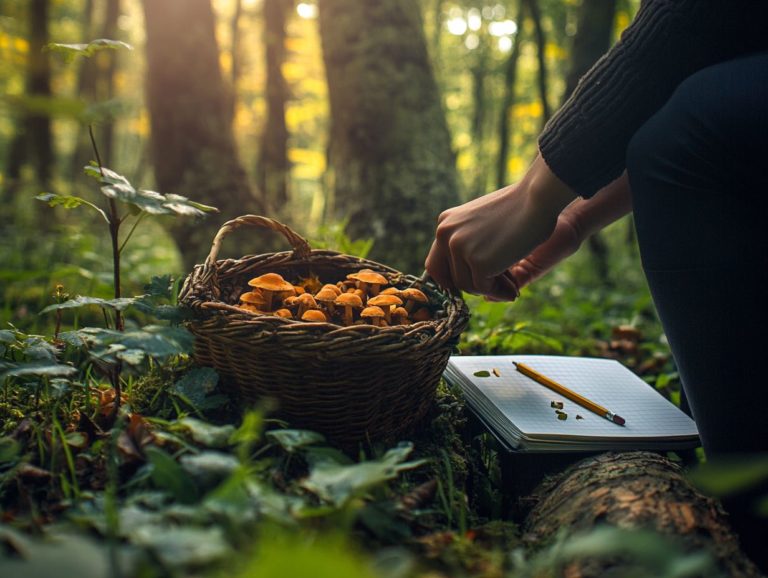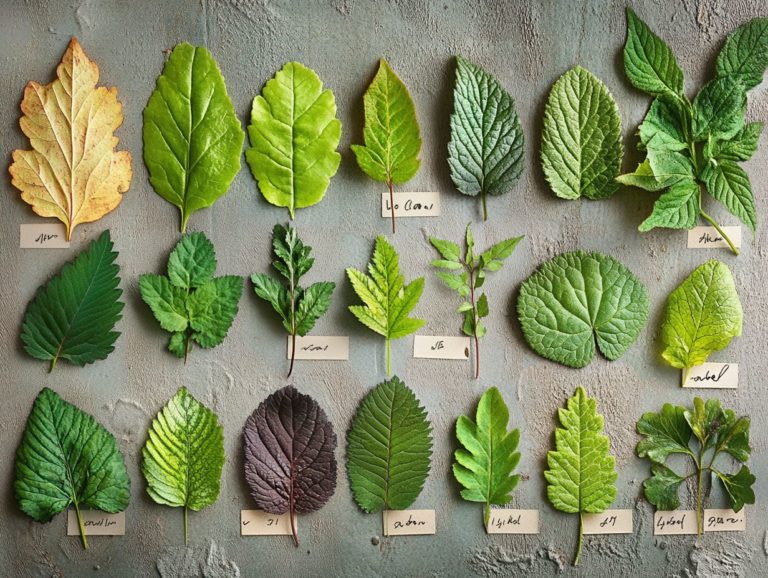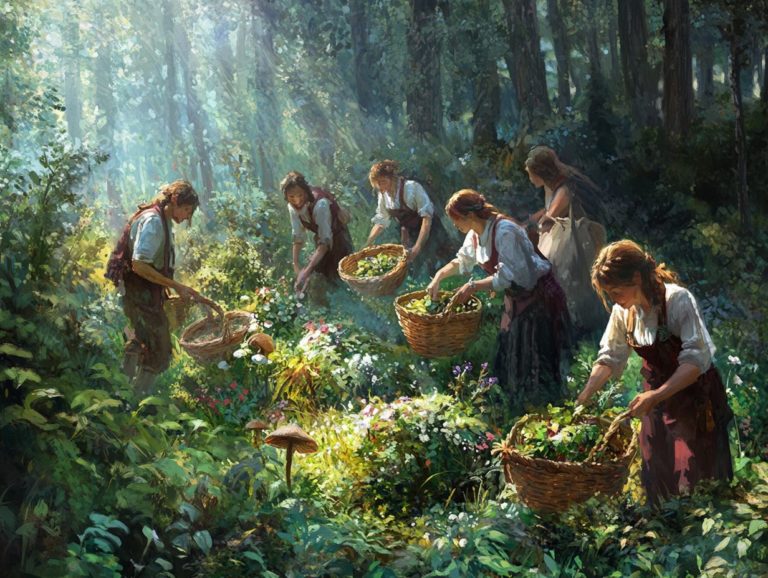How to Identify Edible Plants in the Wild
Foraging for wild edible plants offers an exhilarating opportunity to connect with nature while enriching your culinary skills through nature exploration.
This guide covers the essentials for identifying safe, nutritious plants. You’ll learn to master visual characteristics and recognize common varieties found in different regions, including techniques to identify plants like garlic mustard and wild edibles.
It emphasizes crucial safety precautions and ethical considerations, outlines methods for testing edibility, and provides tips for preparation and cooking.
Whether you re a seasoned forager or a curious newcomer, there s an abundance of foraging knowledge here for anyone eager to explore the wild’s culinary treasures.
Contents
- Key Takeaways:
- Basic Rules for Foraging
- Identifying Edible Plants
- Testing Edibility of Plants
- Methods for Testing Edibility
- Preparing and Cooking Wild Edible Plants
- Methods for Preparation and Cooking
- Summary of Edible Plants in the Wild
- Frequently Asked Questions
- What are some methods for identifying edible plants in the wild?
- What should I look for when trying to identify edible plants?
- Are there any tools that can help with identifying edible plants in the wild?
- What are some common mistakes to avoid when identifying edible plants in the wild?
- What are some safety precautions to take when identifying edible plants in the wild?
- Is it possible to mistakenly identify an edible plant as poisonous?
Key Takeaways:
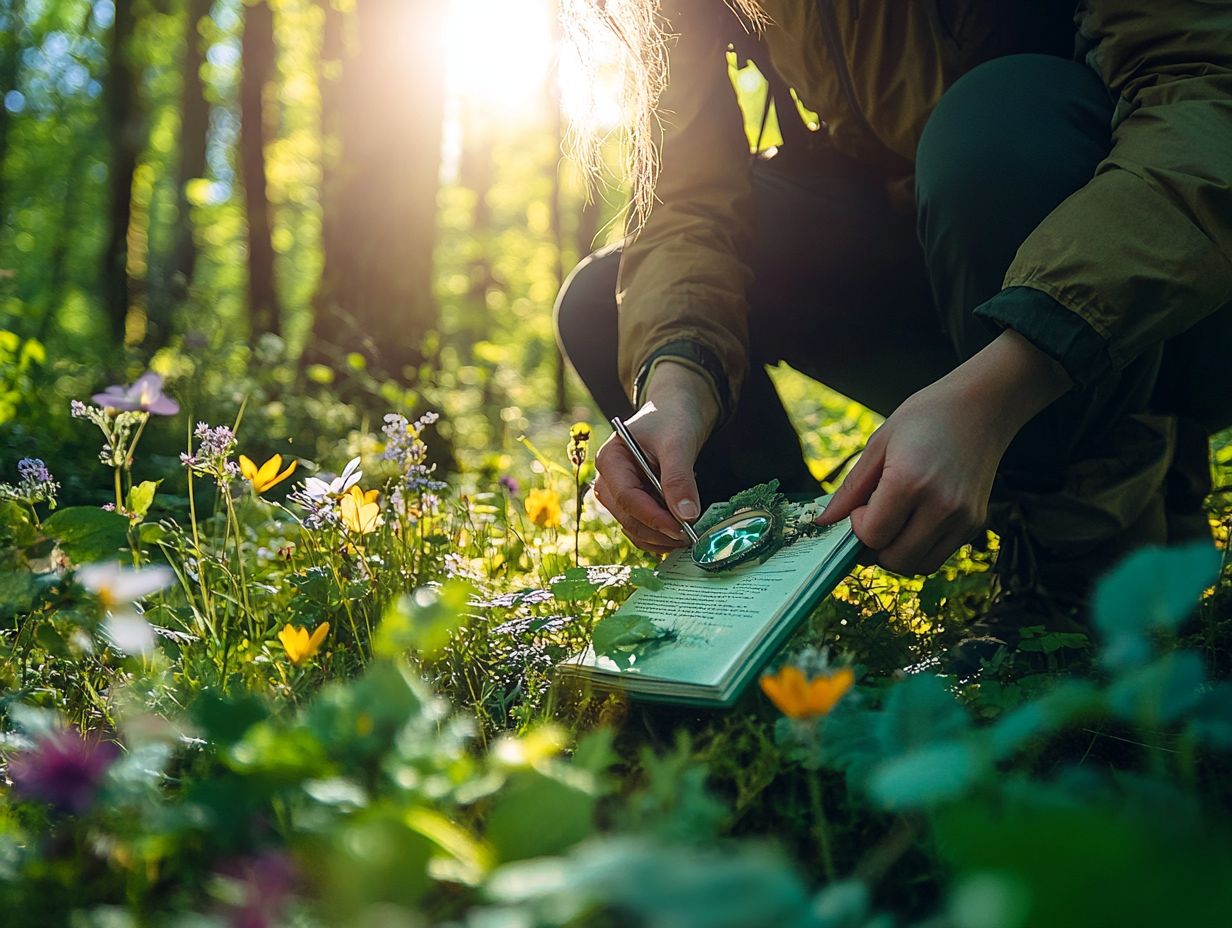
- Always prioritize safety and ethics when foraging.
- Look for visual characteristics such as color, shape, and smell to identify edible plants.
- Before eating any wild plant, properly test its edibility by trying small amounts, and always prepare and cook them properly to avoid any harmful effects.
Why Learn to Identify Edible Plants?
Knowing how to identify edible plants in your region is vital for anyone who loves foraging. It enhances your ability to source nutritious food from nature and fosters self-sufficiency, deepening your appreciation for local ecosystems.
Foraging opens a treasure trove of flavors that often go unnoticed in supermarkets. It encourages a sustainable lifestyle rooted in local and seasonal eating. Many enthusiasts share delightful stories of wandering through woodlands, stumbling upon wild leeks or dandelions, and crafting impromptu meals bursting with unique tastes.
Foraging is an exciting movement that connects us to nature! It champions organic and locally sourced ingredients, evident in community gardens and farmers’ markets. Throughout history, various cultures have celebrated foraging as a way to forge a connection with nature, reminding us that the joy of exploration is woven into our heritage.
Embrace this ancient skill and discover the wonders of nature around you. You cultivate a bond with your surroundings while taking meaningful steps to preserve the environment for future generations.
Basic Rules for Foraging
When you embark on the journey of foraging, following some fundamental rules is essential for ensuring a safe and rewarding experience while exploring nature and identifying wild plants.
These guidelines will assist you in locating and harvesting edible plants efficiently and foster a responsible approach to foraging. This encourages an ethical relationship with the environment and supports the local food movement.
By grasping the principles of foraging, you enable yourself to engage in meaningful explorations while minimizing your impact on ecosystems.
Safety Precautions and Ethical Considerations
Safety precautions are crucial in foraging. Identifying edible plants is only half the battle; understanding potential hazards, like toxic plants, is essential for you as a forager. Ethical considerations should be at the forefront of your mind, ensuring that your foraging practices don t harm local ecosystems or deplete natural resources.
By prioritizing safety and ethics, you can relish the benefits of wild edibles while maintaining a deep respect for nature.
Use the universal edibility test to find out if a plant is safe to eat by trying small amounts over several hours. This careful approach minimizes the risk of adverse reactions.
Utilizing reliable plant identification resources such as field guides or apps can significantly enhance your knowledge and confidence, reducing the likelihood of misidentifying potentially harmful plants.
Practicing ethical foraging is essential. Avoid invasive species that threaten local flora and fauna, and be mindful of wildlife habitats. By respecting these natural spaces, you ensure that foraging remains a sustainable practice for generations to come.
Identifying Edible Plants
Identifying edible plants requires a keen eye and an understanding of the visual traits that differentiate safe wild edibles from toxic ones. Master this skill to enhance your foraging adventures.
This critical knowledge makes foraging exciting! It also helps you avoid the risks tied to consuming unfamiliar plants, transforming your outdoor excursions into a gratifying journey through nature’s edible treasures.
With the help of plant identification apps and expert insights, you can easily learn to recognize a diverse array of wild plants, from everyday herbs to seasonal delights.
Visual Characteristics to Look For
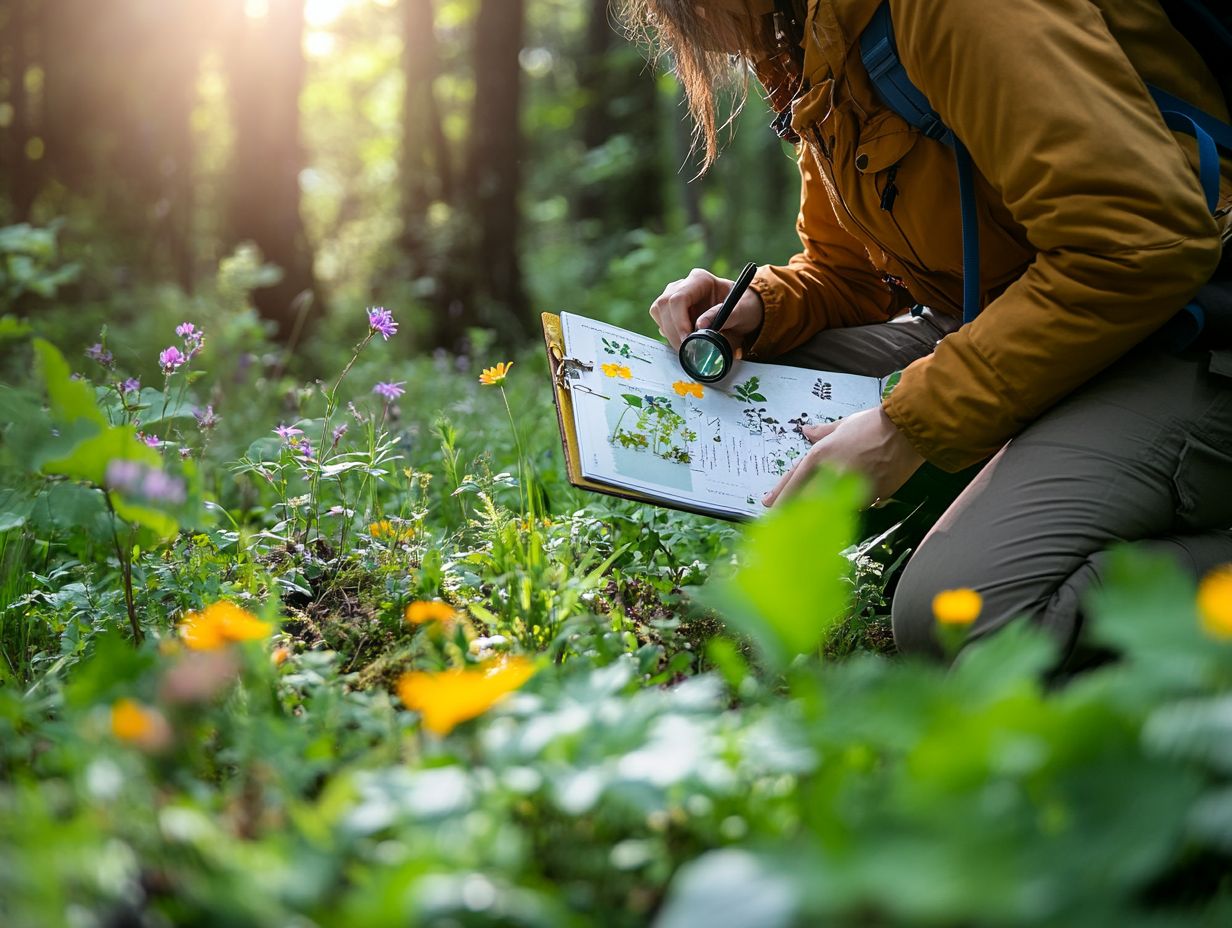
When identifying edible plants, it’s crucial to focus on visual characteristics such as leaf shapes, flower types, and growth habits. Understanding how to identify wild edibles during fall can provide essential clues for distinguishing wild edibles like lamb’s quarters from toxic varieties.
By sharpening your observational skills, you can significantly enhance your foraging knowledge and boost your confidence in recognizing edible species.
Consider the distinctive serrated leaves of wild mustard. Their vibrant green color stands out in spring fields. On the other hand, think about the lush, broad leaves of plantain, characterized by prominent parallel veins another visual cue that aids in identification.
The texture of the leaves plays a role too; for example, the smooth surface of lamb’s quarters distinguishes it from rougher-textured species.
By familiarizing yourself with these characteristics, you can cultivate a deeper appreciation for the diverse flora around you, nurturing a genuine connection with nature as you learn to identify and safely harvest wild edibles.
Common Edible Plants in Different Regions
Different regions present unique opportunities for you to forage for common edible plants. Each area boasts its own array of wild edibles that can differ greatly from California to the American Southwest.
By understanding the local food landscape, you can tap into the traditional knowledge of Native Americans and others who have skillfully harvested these plants for generations. This regional diversity not only enriches your foraging experience but also expands your awareness of the nutritional benefits these plants can offer.
In California, for example, you might find lamb’s quarters, a highly nutritious green that’s perfect for salads or can be cooked like spinach. Venture into the Midwest, and you ll discover burdock roots, which thrive in disturbed areas and are excellent for soups or stir-fries.
Don t overlook acorns from oak trees, abundant in many regions; they can be processed into a flour rich in healthy fats, although you’ll need to leach them to remove the tannins, substances that can make some plants taste bitter, before indulging.
Each of these plants offers not just nourishment but also a cultural heritage, emphasizing the importance of local food systems and the traditional practices that cultivate a deeper connection to the land and its resources.
Testing Edibility of Plants
Testing the edibility of plants is essential for you as a forager. This process allows you to embrace the delights of wild edibles while prioritizing your safety by learning how to identify invasive vs. edible plants.
Not every plant is safe to consume; many can closely resemble their edible counterparts. By employing techniques such as the universal edibility test, you can effectively verify the safety of any suspicious plants.
This gives you the crucial peace of mind as you navigate your foraging adventures. Armed with this knowledge, you can confidently delve into the diverse world of wild plants, all while minimizing the risks posed by toxic species.
Methods for Testing Edibility
There are several methods for testing the edibility of plants, with the universal edibility test being a favored technique among foragers keen on avoiding toxic varieties. This systematic approach allows you to assess a plant’s safety in a controlled manner, making it an essential tool for ensuring that the wild edibles you consume are safe. For a deeper understanding of these techniques, check out the basics of foraging. By using these methods, you can boost your confidence and expertise in identifying plants.
The universal edibility test begins with observing the plant s characteristics. Pay attention to its color, thorns, and growth pattern, as these can provide vital clues about potential toxicity. Next, isolate the plant by placing a small portion on your lip for a few minutes. Then, taste a tiny piece and wait several hours to monitor for any adverse reactions.
Understanding the differences between toxic plants like hemlock and lily of the valley and their safe counterparts is crucial. Dive into studying local flora, consult reliable field guides, and always err on the side of caution when exploring wild edibles. Taking time to research and recognize signs of toxicity can be your best defense against serious health risks while foraging.
Preparing and Cooking Wild Edible Plants
Preparing and cooking wild edible plants is an exhilarating journey for you as a forager. Transforming freshly harvested ingredients into wholesome food that is both nutritious and bursting with unique flavors and textures can be incredibly rewarding.
Mastering the right preparation techniques ensures that these wild edibles are safe to enjoy while enhancing their taste and nutritional benefits. This enriches your culinary experiences and deepens your appreciation for nature s bounty.
It s time to bring your foraging expertise to life in the kitchen!
Methods for Preparation and Cooking

Different methods for preparing and cooking wild edible plants can enhance their flavor and ensure they provide nutritious food while remaining safe for your palate. Techniques like briefly boiling, roasting, or incorporating these ingredients into soups highlight the unique characteristics of each wild edible and enable you to create delicious, wholesome food. Exploring these methods can ignite your culinary creativity.
Take dandelion greens, for example. A simple boiling technique can mellow their bitterness, making them perfect for salads or saut s. To enhance their taste, toss them with a light vinaigrette after boiling.
Now, let s talk about stinging nettle. This wild edible transforms when cooked; boiling removes their sting and turns them into a nutritious addition to soups and a sauce made from crushed herbs. A standout recipe for nettles is creamy nettle soup, where saut ed onions, garlic, and boiled nettles meld together for a hearty dish.
Encouraging experimentation with various cooking techniques will undoubtedly broaden your appreciation for these natural ingredients.
Summary of Edible Plants in the Wild
The landscape of wild edible plants is a true treasure trove, offering a diverse array of options that can elevate your meals while supporting local food movements. To navigate this exciting realm, it’s essential to learn how to spot edible roots in the wild and recognize the key characteristics of these plants, as well as the toxic species that could pose a risk.
By summarizing the edible plants you can find, you can enrich your foraging skills and safely explore the abundant offerings of the natural world.
Start foraging today to discover the incredible flavors nature has to offer!
Key Takeaways and Tips for Foraging Safely
Foraging for wild edibles can be safe and rewarding. Keep these key tips in mind to enhance your knowledge, including identifying edible plants in urban areas, and reduce risks from toxic plants.
Employ best practices such as proper plant identification, using mobile applications that help identify edible plants, and understanding your impact on the environment. You can relish the experience of foraging while respecting nature’s delicate balance.
Engaging with local foraging groups will enrich your understanding of regional flora. Familiarizing yourself with local laws regarding foraging is crucial to ensure compliance and foster respect within the community.
Always remember to cross-reference multiple sources when you re uncertain about a plant s edibility. Emphasizing ethical foraging practices, such as leaving enough plants for wildlife and fellow foragers, deepens your connection to the environment.
Foraging isn’t just about finding food; it s an exciting adventure that deepens your love for nature! It offers an opportunity for continual learning that nurtures a deeper appreciation for the world around you.
Frequently Asked Questions
What are some methods for identifying edible plants in the wild?
You can identify edible plants using a field guide or by asking an expert for help.
What should I look for when trying to identify edible plants?

When identifying edible plants, look for distinct characteristics such as unique shapes and colors, distinctive smells or flavors, and specific growth patterns. For more detailed information, refer to our guide on identifying edible plants along trails.
Are there any tools that can help with identifying edible plants in the wild?
Yes, there are tools such as plant identification apps, kits, and cards that can aid in identifying wild edibles in your local area.
What are some common mistakes to avoid when identifying edible plants in the wild?
One common mistake is misidentifying a poisonous plant as an edible one. Always double-check and verify the plant’s identity before consuming it.
What are some safety precautions to take when identifying edible plants in the wild?
Wear protective gear such as gloves and long sleeves to avoid contact with poisonous plants. Also, make sure to properly wash and cook any edible plants before consuming them.
Is it possible to mistakenly identify an edible plant as poisonous?
Yes, it is possible to mistakenly identify an edible plant as poisonous. That s why it s essential to have a thorough understanding of the plants in your area and to cross-reference with reliable sources before consuming any wild plants.
Start your foraging journey today and enjoy the wonders of wild food!


